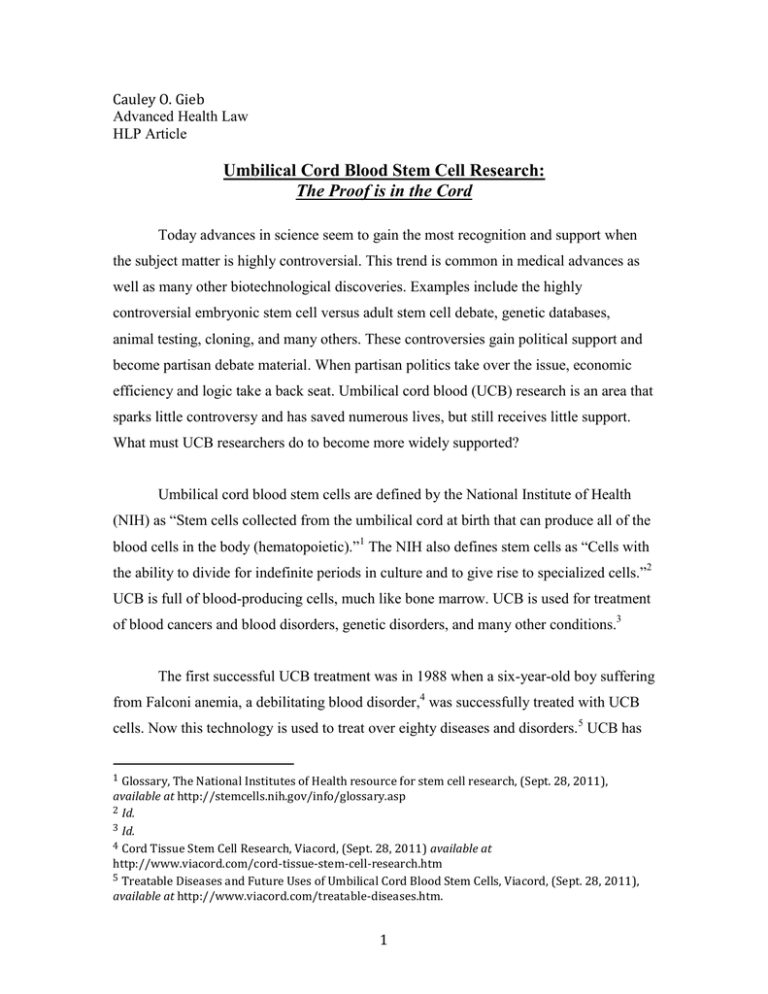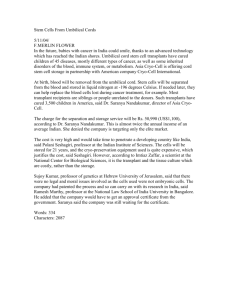Umbilical Cord Blood Stem Cell Research:
advertisement

Cauley O. Gieb Advanced Health Law HLP Article Umbilical Cord Blood Stem Cell Research: The Proof is in the Cord Today advances in science seem to gain the most recognition and support when the subject matter is highly controversial. This trend is common in medical advances as well as many other biotechnological discoveries. Examples include the highly controversial embryonic stem cell versus adult stem cell debate, genetic databases, animal testing, cloning, and many others. These controversies gain political support and become partisan debate material. When partisan politics take over the issue, economic efficiency and logic take a back seat. Umbilical cord blood (UCB) research is an area that sparks little controversy and has saved numerous lives, but still receives little support. What must UCB researchers do to become more widely supported? Umbilical cord blood stem cells are defined by the National Institute of Health (NIH) as “Stem cells collected from the umbilical cord at birth that can produce all of the blood cells in the body (hematopoietic).”1 The NIH also defines stem cells as “Cells with the ability to divide for indefinite periods in culture and to give rise to specialized cells.”2 UCB is full of blood-producing cells, much like bone marrow. UCB is used for treatment of blood cancers and blood disorders, genetic disorders, and many other conditions.3 The first successful UCB treatment was in 1988 when a six-year-old boy suffering from Falconi anemia, a debilitating blood disorder,4 was successfully treated with UCB cells. Now this technology is used to treat over eighty diseases and disorders.5 UCB has 1 Glossary, The National Institutes of Health resource for stem cell research, (Sept. 28, 2011), available at http://stemcells.nih.gov/info/glossary.asp 2 Id. 3 Id. 4 Cord Tissue Stem Cell Research, Viacord, (Sept. 28, 2011) available at http://www.viacord.com/cord-tissue-stem-cell-research.htm 5 Treatable Diseases and Future Uses of Umbilical Cord Blood Stem Cells, Viacord, (Sept. 28, 2011), available at http://www.viacord.com/treatable-diseases.htm. 1 also been very effective and successful in the treatment of leukemia, lymphoma, sicklecell anemia, and has shown great promise in brain trauma studies in children.6 UCB comes either from the patient, (“autologous”), or from a donor, (“allogeneic”).7 Cord blood, bone marrow and peripheral blood stem cells are the three sources used in transplants.8 One large benefit of using UCB is matching UCB to a recipient does not need to be as exact as bone marrow.9 It is also more readily accessible and far less intrusive than obtaining bone marrow from a donor. The best matches are typically family members; however the National Marrow Donor Program (NMDP) states that seven out of ten people will need to go outside their family for a match at some point in their life.10 UCB is often confused with using Embryonic Stem Cells (ESC), but UCB does not use any part of an embryo. UCB cells are obtained from the umbilical cord and placenta after birth. It is recommended that if a parent wishes to donate UCB after their child’s birth they should set the collection procedure with their doctor by the 34th week of pregnancy to ensure a successful and beneficial collection will occur.11 Also, donations incur no cost to the donor. One success story of transplanted non-related donor UCB cells reported by the NMDP is about a little boy named Ajani who was diagnosed with leukemia when he was two years old.12 The doctors gave him just a few months to live unless he could have a UCB transplant. Ajani found a match on the NMDP donor registry and the procedure was done at Duke University Hospital. Ajani is now five years old and has been leukemia-free for three years. Ajani is alive today because of an anonymous donor’s generosity. Numerous cases like Ajani’s have been reported and should be more widely 6 Researchers Study Cord Blood Stem Cells for Pediatric Traumatic Brain Injury, medicalnewstoday.com, (Jan. 6, 2011), http://www.medicalnewstoday.com/releases/212863.php. 7 Cord Blood is Changing Lives Today, National Marrow Donor Program (Sept. 28, 2011), available at http://marrow.org/Get_Involved/Donate_Cord_Blood/Cord_Blood_is_Changing_Lives/Cord_Blood_Is _Changing_Lives_Today.aspx. 8 Id. 9 Id. 10 Id. 11 Id. 12 Id. 2 publicized. The University of Florida has been researching Diabetes Type 1 in children. The goal is to lower and ultimately eliminate the dependence on synthetic insulin.13 The long-term effects are not known yet and complete independence from insulin has not yet been achieved, but researchers are getting closer every day.14 In January 2011, Medical News Today reported that a study at the University of Texas Health Science Center at Houston was approved by the FDA for a Phase I safety study to research the use of UCB cells in traumatic brain injuries.15 The focus is to utilize UCB cells to enable the nerve tissue in the brain to self-heal.16 These non-controversial aspects of UCB research ought to generate more support for this type of research. Although there are an abundance of positive factors to using UCB cells in treatment, therapy and research, there are some inhibiting factors involved. NMDP reports that only fifty percent of the samples collected of cord blood can actually be used in transplants because the sample size is too small. In order for the sample to be useful, certain amount of cells must be extracted, and UCB does not elicit a large amount of these cells.17 On the positive side, when a sample of UCB is donated and found to be too small, it is not discarded, but used in research. No sample is wasted because research of UCB cells is ongoing. Presently, blood cancers, blood disorders, and certain genetic disorders are the only areas with clinically effective UCB treatments and even these are still considered investigational.18 At this time there is no concrete proof that these cells can differentiate into another type of cell, as seen with embryonic stem cells. The positive and life-saving results, however, and the speed at which this technology has emerged, gives every reason 13 MJ Haller, et al., Autologous umbilical cord blood infusion for type 1 diabetes, U.S. National Library of Medicine, National Institutes of Health, (2008) http://www.ncbi.nlm.nih.gov/pubmed/18358588 14 Id. 15 Researchers Study Cord Blood Stem Cells for Pediatric Traumatic Brain Injury, medicalnewstoday.com, Jan. 6, 2011. 16 Id. 17 Cord Blood Donation: Frequently Asked Questions, National Marrow Donor Program, available at http://marrow.org/Get_Involved/Donate_Cord_Blood/Cord_Blood_FAQs.aspx. 18 Umbilical Cord Blood Donation, National Multiple Sclerosis Society, available at http://www.nationalmssociety.org/research/researchers-need-you/donate-to-tissuebanks/umbilical-cord-blood-donation/index.aspx 3 to increase funding and make the option of donation of these cells at birth more widespread. The U.S. Food and Drug Administration regulates UCB under Title 21 Section 1271 “Human Cells, Tissues, and Cellular and Tissue Based-Products”.19 In 2005 the Therapeutic and Research Act of 2005 was enacted by the U.S. Congress, and later amended in 2010 by the Stem Cell Therapeutic and Research Reauthorization Act of 2010.20 The 2005 Act authorized the C.W. Bill Young Cell Transplantation Program.21 The National Marrow Donor Program (NMDP) was given the contract to implement the requirements of the Program.22 Implementation of existing legislation is key to the success of UCB transplants and donations. Without the federal government’s help, access to UCB will be difficult or non-existent for many people. Even with enacted legislation and current levels of funding, UCB needs much more public support to reach its potential. NMDP was selected as the coordination center for all UCB and bone marrow donations and research. NMDP created the National Cord Blood Inventory (NCBI) which makes donations, finding a match, and distribution to patients much easier. The C.W. Bill Young Cell Transplantation Program allows NMDP to receive funding for its work in coordinating the vast amount of information required.23 The federal government funds the NMDP to facilitate a registry, but it does not fully support UCB research. Though the Stem Cell section of the National Institutes of Health (NIH) website maintains extensive lists all of the different kinds of stem cell research, the only thing listed under UCB is where to donate. Many other kinds of 19 21 C.F.R. 1271 Stem Cell Therapeutic and Research Reauthorization Act of 2010, Pub. L. No. 111-264, 119 Stat. 3751 (codified as amended at 42 U.S.C §§ 201-274m). 21 Stem Cell Therapeutic and Research Act of 2005, Pub. L. No. 109-129, 119 Stat. 2550 (codified as amended at 42 U.S.C §§ 201-274m). 22 Federal Cord Blood Legislation, National Marrow Donor Program, available at http://marrow.org/Get_Involved/Donate_Cord_Blood/Cord_Blood_is_Changing_Lives/Federal_Legisl ation.aspx. 23 Id. 20 4 scientific research results are listed and emphasized on the NIH website, and as an agency for the government, one would logically expect UCB information to be listed in more detail. Patients desperately searching for treatment answers and options should be able to find more than just a promise of potential future results of ESC research. This lack of information and support is unacceptable. The basic information for UCB research should be communicated through the NIH website and not just linked to other websites and authorities. People look to the government agencies for answers, and they should get basic guidance on their options. The present state of the U.S. economy is a central argument for increased funding and support of UCB research over other forms of research. Many other research areas are highly controversial and have produced limited or no positive results. The government has a responsibility to encourage scientific innovation and research. However the government also has a duty to not waste fiscal resources. During these hard times where health care reform is up in the air and serves as the punch line to late night comedy jokes, people need to know that their tax dollars are being spent wisely and the investment in research is one that might actually help them at a later date no matter where the health reform fight ends. The answer is to make this research a public issue even though it is not riddled with controversy. Health Law Perspectives (2012) Health Law & Policy Institute University of Houston Law Center http://www.law.uh.edu/healthlaw/perspectives/homepage.asp The opinions, beliefs and viewpoints expressed by the various Health Law Perspectives authors on this web site do not necessarily reflect the opinions, beliefs, viewpoints, or official policies of the Health Law & Policy Institute and do not constitute legal advice. The Health Law & Policy Institute is part of the University of Houston Law Center. It is guided by an advisory board consisting of leading academicians, health law practitioners, representatives of area institutions, and public officials. A primary mission of the Institute is to provide policy analysis for members of the Texas Legislature and health and human service agencies in state government. 5





